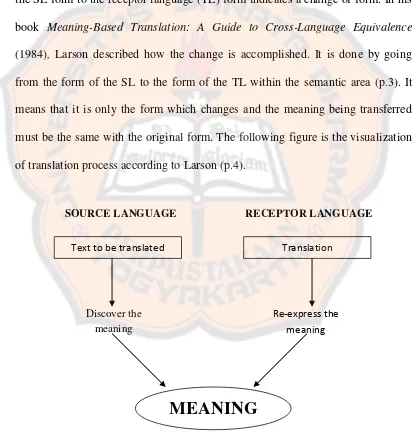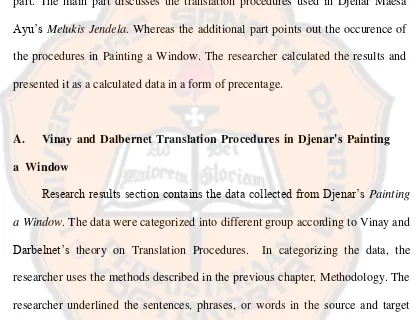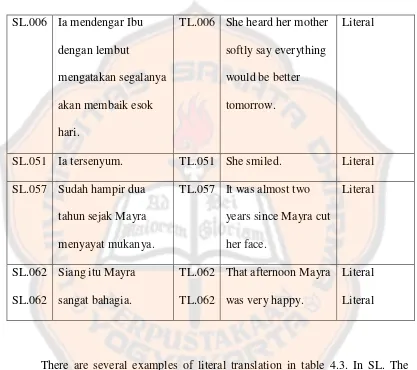Informasi Dokumen
- Penulis:
- Yuvita Ardhani
- Pengajar:
- Drs. Barli Bram M.Ed., Ph.D.
- Sekolah: Sanata Dharma University
- Mata Pelajaran: English Language Education
- Topik: Vinay and Darbelnet's Translation Procedures in Djenar's Painting a Window
- Tipe: thesis
- Tahun: 2015
- Kota: Yogyakarta
Ringkasan Dokumen
I. INTRODUCTION
This section lays the groundwork for the study, introducing the significance of translation in literary contexts. The researcher discusses the controversial nature of Djenar Maesa Ayu's work, which has sparked debate among readers regarding its explicit content. The introduction outlines the purpose of the research, which focuses on analyzing Vinay and Darbelnet’s translation procedures as applied to Djenar’s short story 'Melukis Jendela' and its English translation 'Painting a Window'. The relevance of the study to educational objectives is emphasized, particularly in enhancing students' understanding of translation methodologies.
1.1 Research Background
The background highlights the role of literature in providing insights into human experience and the importance of translation in making these works accessible to a broader audience. It discusses the emergence of Djenar Maesa Ayu as a significant figure in modern Indonesian literature and the mixed reception of her work, which serves as a focal point for this research.
1.2 Research Problem
The primary research question addresses the identification of Vinay and Darbelnet’s translation procedures in Djenar’s work. This problem is crucial for understanding how translation techniques can affect the interpretation and reception of literary texts, which is a key learning outcome for students in translation studies.
1.3 Research Objectives
The objectives of the research are twofold: to analyze the translation procedures utilized in 'Painting a Window' and to determine which procedure is most frequently applied. This analysis aims to enhance students' analytical skills and their ability to critically evaluate translation strategies.
1.4 Research Benefits
The study is expected to benefit various stakeholders, including students of the English Language Education Study Program, general readers interested in translated literature, and future researchers. By understanding translation procedures, students can develop a critical perspective on translation quality and its implications for cross-cultural communication.
1.5 Definition of Terms
Key terms such as 'translation', 'Vinay and Darbelnet’s translation procedures', and 'literary translation' are defined to provide clarity and context for the study. This section is essential for ensuring that readers and students grasp the foundational concepts that underpin the research.
II. REVIEW OF RELATED LITERATURE
This chapter reviews relevant theories and literature that inform the study. It discusses the nature of translation, the theoretical framework of Vinay and Darbelnet’s procedures, and how these concepts apply to literary texts. Understanding these theories is vital for students as it provides them with the necessary tools to analyze translation practices.
2.1 Theoretical Description
This section provides an overview of translation theories, emphasizing the significance of Vinay and Darbelnet’s procedures. It outlines each procedure, including borrowing, calque, literal translation, transposition, modulation, equivalence, and adaptation, providing examples to illustrate their application. This theoretical foundation is crucial for students as it helps them comprehend the complexities of translation.
2.2 Theoretical Framework
The theoretical framework synthesizes the previously discussed theories and outlines how they will be applied in the analysis of Djenar’s work. This framework serves as a guide for students to understand how to systematically approach translation studies and analyze specific texts.
III. METHODOLOGY
This chapter outlines the research design and methods used to collect and analyze data. The qualitative approach is justified, and the specific steps taken to gather and categorize data are detailed. This methodological rigor is essential for students to learn how to conduct thorough research in translation studies.
3.1 Research Method
The qualitative content analysis method is employed to explore the translation procedures in depth. This choice is significant for students as it emphasizes the importance of qualitative research in understanding nuanced aspects of translation.
3.2 Research Subjects
The subjects of the study are identified as Djenar’s short story 'Melukis Jendela' and its English translation 'Painting a Window'. This focus allows students to engage with specific texts and understand the application of translation theories in real-world contexts.
3.3 Data Analysis Techniques
The techniques used for data analysis are described, including categorization and measurement of translation procedures. This section provides students with practical skills in analyzing texts and applying theoretical frameworks.
IV. RESEARCH RESULTS AND DISCUSSION
This chapter presents the findings of the research, detailing the application of Vinay and Darbelnet’s procedures in the translations. The results are discussed in relation to the research objectives, providing insights into the effectiveness of different translation strategies. This analysis is crucial for students to learn how to interpret research findings and draw conclusions based on data.
4.1 Vinay and Darbelnet’s Translation Procedures in Djenar’s Painting a Window
The results of the analysis reveal the specific translation procedures used in 'Painting a Window'. Each procedure is examined, and examples are provided to illustrate their application. This detailed examination helps students understand the practical implications of translation theories.
4.2 Occurrence Frequency of Translation Procedures
The frequency of each translation procedure is calculated and discussed. This quantitative analysis allows students to see patterns in translation practices and understand which strategies are most effective in conveying meaning across languages.
V. CONCLUSIONS AND RECOMMENDATIONS
The final chapter summarizes the key findings of the research and their implications for translation studies. Recommendations for future research and practical applications in educational settings are provided. This section is critical for students as it encourages them to think about how their learning can be applied in real-world contexts.
5.1 Conclusions
The conclusions drawn from the research highlight the importance of understanding translation procedures in literary contexts. This understanding is vital for students pursuing careers in translation and related fields.
5.2 Recommendations
Recommendations for further research and practical applications in the classroom are discussed. This section encourages students to engage with ongoing research in translation studies and consider how they can contribute to the field.









